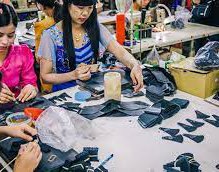@KhmerTimes writes: "A new leather goods factory in the province of Kampong Speu in Cambodia, will create more than 2,000 jobs" and @fibre2fashion recalls that there are currently 186 shoe factories in the province of Kampong Speu that employ 148,367, including 115,475 women. Chiosa @WTPfootwear: "One of the main destinations for the migration of Chinese leather goods entrepreneurs in recent years has been Cambodia." Outside Southeast Asia, however, the emergence of financial problems related to the Belt & Road Initiatives (BRI) program is slowing the expansion of Chinese production sites around the world.
According to World Leather & Leatherbiz [China manufacturers seek refuge and savings in Cambodia – leatherbiz], the rise in labor costs in China, as the population has become more prosperous over the past 20 years, has prompted many Chinese manufacturers to seek lower costs abroad.
The zero-covid policy has also accelerated this exodus of production from China as the pandemic persists.
One of the main destinations for the migration of Chinese manufacturers of leather products in recent years has been Cambodia.
Chinese leather goods entrepreneurs are investing outside of China in search of lower labor costs and thus improve their competitiveness in the outsourcing market.
The latest example, reported by Khmer Times [Over 2000 jobs created at Kampong Speu, Cambodia's new ... – Khmer Times] is from anew leather factory, started in the province of Kampong Speu in Cambodia, which will create more than 2,000 jobs. The Governor of Kampong Speu, Vy Samnang, led a delegation to recently inaugurate the Milanna Leather Ware MFY Cambogia Co Ltd factory.
Samnang attributed peace in the region to creating several business opportunities for investors in Cambodia, according to various Cambodian media reports. The governor also expressed his gratitude to the factory owners who invested in Kampong Speu. The opening ceremony of the new factory took place in Krabei Tram village, Chung Ruk municipality, Kong Pisey district, Kampong Speu.
On the theme, Fibre2Fashion [New Kampong Speu leather factory in Cambodia to offer over ... – F2F] notes that Chinese-owned leather goods and footwear manufacturersare already established in Cambodia. The leather sector has 186 active companies in the Cambodian province of Kampong Speu, employing more than 148,000 people, with over 115 thousand female workers and most of these companies are Chinese-owned.
Foreign investment in Cambodia did not begin with enterprises from China, but began when, wary of China, Western companies began to head to Cambodia.
In 2013, the EPZ, Special Economic Zone, began operating in Phnom Penh.
It all started when some of Japan's biggest manufacturers rushed to start businesses in Phnom Penh to make car wiring, touch screens, and vibration motors for mobile phones. European companies are no different, making shoes and clothing.
Foreign companies were pouring into Cambodia for a simple reason. They wanted to limit their overwhelming dependence on factories in China.
The problems were multiplying rapidly for foreign investors in China. Blue-collar wages rose, quadrupling in the first decade of the twenty-first century, as the boom in factory construction coincided with the decline in the number of young people interested in factory work. As of 2021, the workforce in China began to shrink as a result of shrinking due to the "one child" policy and an aging population.
So the multinationals discovered how to escape from China's rising wages, but for many industrial sectors it was not possible to completely transfer production.
The populations, economies and even electricity production of most Southeast Asian countries smaller than in many Chinese provinces and sometimes smaller than a single Chinese city. As companies moved south, they quickly consumed local labor stocks, and wages there also increased dramatically.
Here then, in 2013, China entered the furrow of relocation carried out by Western companies, but by launching the "Belt and Road Initiative (BRI)" program, also known as "the new silk roads", it tried to improve the industrial and logistical infrastructure of Asian countries where the interest of Chinese companies to build new factories began to be directed.
Now Chinese relocations , especially in the countries of Southeast Asia is booming, less so in the other countries of Asia and Africa due to the economic problems that have emerged in the last two years in many countries where the BRI has been launched.
China is perhaps the big player here. It has prepared for its emergence as a global power, and we have witnessed several parts of its strategy: the Belt and Road Initiative, of course, but beyond that, a strategy of lending to emerging and low-income countries. In the specific case of Sri Lanka, debt restructuring negotiations are delicate because China is not part of the Paris Club and often asks for collateral to support its loans, which are often disbursed through state bodies. China is a tough negotiator and will not necessarily coordinate with other creditors to accept cuts or losses. This can be a major obstacle in negotiations because if only one lender refuses to accept the haircut, the freerider problem can lead to a stalemate and debt restructuring is delayed or does not happen. Although some debt relief to African countries has been agreed by China, most Chinese loans in Africa, in the form of subsidized loans and trade loans, have not been canceled. Sri Lanka will not be the only case where the multilateral sovereign debt restructuring system will be in trouble due to China's strong position as a global lender. Carmen Reinhart and her co-authors, as well as Anna Gelpern, have discovered many Chinese loans that are not always highlighted in official statistics. For African economies and the Belt and Road Initiative, chinese lending represents a large chunk of beneficiary countries' GDP with huge guarantees: if the country defaults on its debt, it will lose large infrastructure (ports, for example) to China's advantage for a long time.
The emergence of these problems is slowing the expansion of Chinese production sites around the world.



